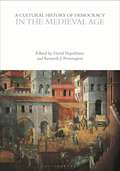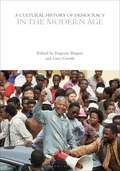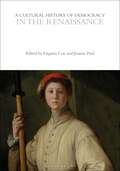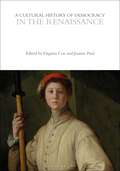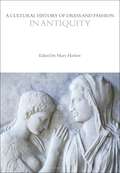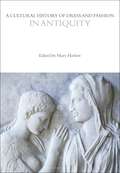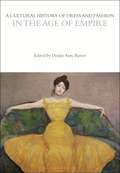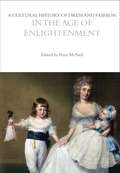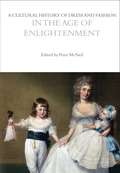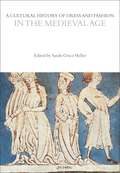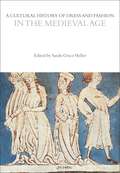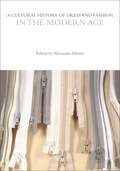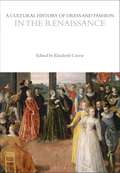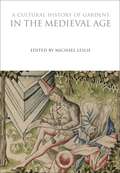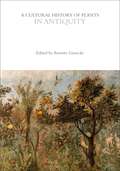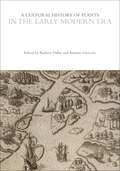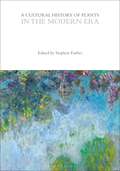- Table View
- List View
A Cultural History of Democracy in the Medieval Age (The Cultural Histories Series)
by Eugenio BiaginiOffering a broad exploration of the cultural history of democracy in the medieval age, this volume claims that, though not generally associated with the term, the Middle Ages deserve to be included in a general history of democracy. The term was never widely employed during this period, the dominant attitude towards democracy was outright hostility, and none of the medieval polities thought of itself as a democracy. Despite this, this study highlights a wide variety of ideas, practices, procedures, and institutions that, although different from their ancient predecessor (direct democracy) or modern successor (liberal representative democracy), played a significant role in the history of democracy. This volume covers almost 1,000 years and a wide range of territories. It deals with different political spheres (ecclesiastical and secular) and socio-political settings (courtly, urban, and rural) and examines the phenomenon from the local level up to the universal realm. This volume adopts a broad cultural approach and is structured thematically. Each chapter takes a theme as its focus: sovereignty; liberty and the rule of law; the common good; economic and social democracy; religion and the principles of political obligation; citizenship and gender; ethnicity, race, and nationalism; democratic crises, revolutions, and civil resistance; international relations; and the scalability of democracy beyond the limits of a single city. These ten themes add up to an extensive, synoptic coverage of the subject.
A Cultural History of Democracy in the Modern Age (The Cultural Histories Series)
by Eugenio F. Biagini and Gary GerstleThis volume explores democracy in the 20th century, examining the triumph, crises, recovery, and resilience of democracy and its associated cultures in this period.From 1920 democracy became the hegemonic discourse in political cultures, to the extent that even its enemies claimed its legacy. The end of empires ushered in an unprecedented globalization of democratic aspirations. Barriers of gender and race were gradually removed, and greater equality gave new meaning to citizenship. Yet, already in 1922 democracy was on its back foot with the rise of fascism. Even after the latter's defeat in 1945, liberal democracy died wherever communist democracy triumphed. The situation changed again from 1989, but democratic hubris was then checked by the rise of a new enemy-populism. The paradox is that the century of democracy's triumph was also that of its near final defeat, while the peace and stability that everybody desired and many expected as the outcome of the extension of democracy were, at best, intermittent and geographically limited. Each chapter takes a different theme as its focus: sovereignty; liberty and the rule of law; the “common good”; economic and social democracy; religion and the principles of political obligation; citizenship and gender; ethnicity, race, and nationalism; democratic crises, revolutions, and civil resistance; international relations; and democratic politics beyond the polis. These ten different approaches to democracy since 1920 offer a global, synoptic, and probing exploration of the subject.
A Cultural History of Democracy in the Modern Age (The Cultural Histories Series)
This volume explores democracy in the 20th century, examining the triumph, crises, recovery, and resilience of democracy and its associated cultures in this period.From 1920 democracy became the hegemonic discourse in political cultures, to the extent that even its enemies claimed its legacy. The end of empires ushered in an unprecedented globalization of democratic aspirations. Barriers of gender and race were gradually removed, and greater equality gave new meaning to citizenship. Yet, already in 1922 democracy was on its back foot with the rise of fascism. Even after the latter's defeat in 1945, liberal democracy died wherever communist democracy triumphed. The situation changed again from 1989, but democratic hubris was then checked by the rise of a new enemy-populism. The paradox is that the century of democracy's triumph was also that of its near final defeat, while the peace and stability that everybody desired and many expected as the outcome of the extension of democracy were, at best, intermittent and geographically limited. Each chapter takes a different theme as its focus: sovereignty; liberty and the rule of law; the “common good”; economic and social democracy; religion and the principles of political obligation; citizenship and gender; ethnicity, race, and nationalism; democratic crises, revolutions, and civil resistance; international relations; and democratic politics beyond the polis. These ten different approaches to democracy since 1920 offer a global, synoptic, and probing exploration of the subject.
A Cultural History of Democracy in the Renaissance (The Cultural Histories Series)
by Virginia Cox and Joanne PaulThis volume offers a broad exploration of the cultural history of democracy in the Renaissance. The Renaissance has rarely been considered an important moment in the history of democracy. Nonetheless, as this volume shows, this period may be seen as a “democratic laboratory” in many, often unexpected, ways. The classicizing cultural movement known as humanism, which spread throughout Europe and beyond in this period, had the effect of vastly enhancing knowledge of the classical democratic and republican traditions. Greek history and philosophy, including the story of Athenian democracy, became fully known in the West for the first time in the postclassical world. Partly as a result of this, the period from 1400 to 1650 witnessed rich and historically important debates on some of the enduring political issues at the heart of democratic culture: issues of sovereignty, of liberty, of citizenship, of the common good, of the place of religion in government. At the same time, the introduction of printing, and the emergence of a flourishing, proto-journalistic news culture, laid the basis for something that recognizably anticipates the modern “public sphere.” The expansion of transnational and transcontinental exchange, in what has been called the “age of encounters,” gave a new urgency to discussions of religious and ethnic diversity. Gender, too, was a matter of intense debate in this period, as was, specifically, the question of women's relation to political agency and power. This volume explores these developments in ten chapters devoted to the notions of sovereignty, liberty, and the “common good”; the relation of state and household; religion and political obligation; gender and citizenship; ethnicity, diversity, and nationalism; democratic crises and civil resistance; international relations; and the development of news culture. It makes a pressing case for a fresh understanding of modern democracy's deep roots.
A Cultural History of Democracy in the Renaissance (The Cultural Histories Series)
This volume offers a broad exploration of the cultural history of democracy in the Renaissance. The Renaissance has rarely been considered an important moment in the history of democracy. Nonetheless, as this volume shows, this period may be seen as a “democratic laboratory” in many, often unexpected, ways. The classicizing cultural movement known as humanism, which spread throughout Europe and beyond in this period, had the effect of vastly enhancing knowledge of the classical democratic and republican traditions. Greek history and philosophy, including the story of Athenian democracy, became fully known in the West for the first time in the postclassical world. Partly as a result of this, the period from 1400 to 1650 witnessed rich and historically important debates on some of the enduring political issues at the heart of democratic culture: issues of sovereignty, of liberty, of citizenship, of the common good, of the place of religion in government. At the same time, the introduction of printing, and the emergence of a flourishing, proto-journalistic news culture, laid the basis for something that recognizably anticipates the modern “public sphere.” The expansion of transnational and transcontinental exchange, in what has been called the “age of encounters,” gave a new urgency to discussions of religious and ethnic diversity. Gender, too, was a matter of intense debate in this period, as was, specifically, the question of women's relation to political agency and power. This volume explores these developments in ten chapters devoted to the notions of sovereignty, liberty, and the “common good”; the relation of state and household; religion and political obligation; gender and citizenship; ethnicity, diversity, and nationalism; democratic crises and civil resistance; international relations; and the development of news culture. It makes a pressing case for a fresh understanding of modern democracy's deep roots.
A Cultural History of Dress and Fashion in Antiquity (The Cultural Histories Series)
by Mary HarlowWhilst seemingly simple garments such as the tunic remained staples of the classical wardrobe, sources from the period reveal a rich variety of changing styles and attitudes to clothing across the ancient world. Covering the period 500 BCE to 800 CE and drawing on sources ranging from extant garments and architectural iconography to official edicts and literature, this volume reveals Antiquity's preoccupation with dress, which was matched by an appreciation of the processes of production rarely seen in later periods. From a courtesan's sheer faux-silk garb to the sumptuous purple dyes of an emperor's finery, clothing was as much a marker of status and personal expression as it was a site of social control and anxiety. Contemporary commentators expressed alarm in equal measure at the over-dressed, the excessively ascetic or at 'barbarian' silhouettes. Richly illustrated with 100 images, A Cultural History of Dress and Fashion in Antiquity presents an overview of the period with essays on textiles, production and distribution, the body, belief, gender and sexuality, status, ethnicity, visual representations, and literary representations.
A Cultural History of Dress and Fashion in Antiquity (The Cultural Histories Series)
by Mary HarlowWhilst seemingly simple garments such as the tunic remained staples of the classical wardrobe, sources from the period reveal a rich variety of changing styles and attitudes to clothing across the ancient world. Covering the period 500 BCE to 800 CE and drawing on sources ranging from extant garments and architectural iconography to official edicts and literature, this volume reveals Antiquity's preoccupation with dress, which was matched by an appreciation of the processes of production rarely seen in later periods. From a courtesan's sheer faux-silk garb to the sumptuous purple dyes of an emperor's finery, clothing was as much a marker of status and personal expression as it was a site of social control and anxiety. Contemporary commentators expressed alarm in equal measure at the over-dressed, the excessively ascetic or at 'barbarian' silhouettes. Richly illustrated with 100 images, A Cultural History of Dress and Fashion in Antiquity presents an overview of the period with essays on textiles, production and distribution, the body, belief, gender and sexuality, status, ethnicity, visual representations, and literary representations.
A Cultural History of Dress and Fashion in the Age of Empire (The Cultural Histories Series)
by Denise Amy BaxterDuring the nineteenth and early twentieth centuries the production of dress shifted dramatically from being predominantly hand-crafted in small quantities to machine-manufactured in bulk. The increasing democratization of appearances made new fashions more widely available, but at the same time made the need to differentiate social rank seem more pressing. In this age of empire, the coding of class, gender and race was frequently negotiated through dress in complex ways, from fashionable dress which restricted or exaggerated the female body to liberating reform dress, from self-defining black dandies to the oppressions and resistances of slave dress. Richly illustrated with over 100 images and drawing on a plethora of visual, textual and object sources, A Cultural History of Dress and Fashion in the Age of Empire presents essays on textiles, production and distribution, the body, belief, gender and sexuality, status, ethnicity, and visual and literary representations to illustrate the diversity and cultural significance of dress and fashion in the period.
A Cultural History of Dress and Fashion in the Age of Empire (The Cultural Histories Series)
During the nineteenth and early twentieth centuries the production of dress shifted dramatically from being predominantly hand-crafted in small quantities to machine-manufactured in bulk. The increasing democratization of appearances made new fashions more widely available, but at the same time made the need to differentiate social rank seem more pressing. In this age of empire, the coding of class, gender and race was frequently negotiated through dress in complex ways, from fashionable dress which restricted or exaggerated the female body to liberating reform dress, from self-defining black dandies to the oppressions and resistances of slave dress. Richly illustrated with over 100 images and drawing on a plethora of visual, textual and object sources, A Cultural History of Dress and Fashion in the Age of Empire presents essays on textiles, production and distribution, the body, belief, gender and sexuality, status, ethnicity, and visual and literary representations to illustrate the diversity and cultural significance of dress and fashion in the period.
A Cultural History of Dress and Fashion in the Age of Enlightenment (The Cultural Histories Series)
by Peter McNeilEighteenth-century fashion was cosmopolitan and varied. Whilst the wildly extravagant and colorful elite fashions parodied in contemporary satire had significant influence on wider dress habits, more austere garments produced in darker fabrics also reflected the ascendancy of a puritan middle class as well as a more practical approach to dress. With the rise of print culture and reading publics, fashions were more quickly disseminated and debated than ever, and the appetite for fashion periodicals went hand in hand with a preoccupation with the emerging concept of taste. Richly illustrated with 100 images and drawing on pictorial, textual and object sources, A Cultural History of Dress and Fashion in the Age of Enlightenment presents essays on textiles, production and distribution, the body, belief, gender and sexuality, status, ethnicity, and visual and literary representations to illustrate the diversity and cultural significance of dress and fashion in the period.
A Cultural History of Dress and Fashion in the Age of Enlightenment (The Cultural Histories Series)
by Peter McNeilEighteenth-century fashion was cosmopolitan and varied. Whilst the wildly extravagant and colorful elite fashions parodied in contemporary satire had significant influence on wider dress habits, more austere garments produced in darker fabrics also reflected the ascendancy of a puritan middle class as well as a more practical approach to dress. With the rise of print culture and reading publics, fashions were more quickly disseminated and debated than ever, and the appetite for fashion periodicals went hand in hand with a preoccupation with the emerging concept of taste. Richly illustrated with 100 images and drawing on pictorial, textual and object sources, A Cultural History of Dress and Fashion in the Age of Enlightenment presents essays on textiles, production and distribution, the body, belief, gender and sexuality, status, ethnicity, and visual and literary representations to illustrate the diversity and cultural significance of dress and fashion in the period.
A Cultural History of Dress and Fashion in the Medieval Age (The Cultural Histories Series)
by Sarah-Grace HellerDuring the medieval period, people invested heavily in looking good. The finest fashions demanded careful chemistry and compounds imported from great distances and at considerable risk to merchants; the Church became a major consumer of both the richest and humblest varieties of cloth, shoes, and adornment; and vernacular poets began to embroider their stories with hundreds of verses describing a plethora of dress styles, fabrics, and shopping experiences. Drawing on a wealth of pictorial, textual and object sources, the volume examines how dress cultures developed – often to a degree of dazzling sophistication – between the years 800 to 1450. Beautifully illustrated with 100 images, A Cultural History of Dress and Fashion in the Medieval Age presents an overview of the period with essays on textiles, production and distribution, the body, belief, gender and sexuality, status, ethnicity, visual representations, and literary representations.
A Cultural History of Dress and Fashion in the Medieval Age (The Cultural Histories Series)
During the medieval period, people invested heavily in looking good. The finest fashions demanded careful chemistry and compounds imported from great distances and at considerable risk to merchants; the Church became a major consumer of both the richest and humblest varieties of cloth, shoes, and adornment; and vernacular poets began to embroider their stories with hundreds of verses describing a plethora of dress styles, fabrics, and shopping experiences. Drawing on a wealth of pictorial, textual and object sources, the volume examines how dress cultures developed – often to a degree of dazzling sophistication – between the years 800 to 1450. Beautifully illustrated with 100 images, A Cultural History of Dress and Fashion in the Medieval Age presents an overview of the period with essays on textiles, production and distribution, the body, belief, gender and sexuality, status, ethnicity, visual representations, and literary representations.
A Cultural History of Dress and Fashion in the Modern Age (The Cultural Histories Series)
by Alexandra PalmerOver the last century there has been a complete transformation of the fashion system. The unitary top-down fashion cycle has been replaced by the pulsations of multiple and simultaneous styles, while the speed of global production and circulation has become ever faster and more complex. Running in tandem, the development of artificial fibres has revolutionized the composition of clothing, and the increased focus on youth, sexuality, and the body has radically changed its design. From the 1920s flapper dress to debates over the burkini, fashion has continued to be deeply involved in society's larger issues.Drawing on a wealth of visual, textual and object sources and illustrated with 100 images, A Cultural History of Dress and Fashion in the Modern Age presents essays on textiles, production and distribution, the body, belief, gender and sexuality, status, ethnicity, and visual and literary representations to illustrate the diversity and cultural significance of dress and fashion in the period.
A Cultural History of Dress and Fashion in the Modern Age (The Cultural Histories Series)
by Alexandra PalmerOver the last century there has been a complete transformation of the fashion system. The unitary top-down fashion cycle has been replaced by the pulsations of multiple and simultaneous styles, while the speed of global production and circulation has become ever faster and more complex. Running in tandem, the development of artificial fibres has revolutionized the composition of clothing, and the increased focus on youth, sexuality, and the body has radically changed its design. From the 1920s flapper dress to debates over the burkini, fashion has continued to be deeply involved in society's larger issues.Drawing on a wealth of visual, textual and object sources and illustrated with 100 images, A Cultural History of Dress and Fashion in the Modern Age presents essays on textiles, production and distribution, the body, belief, gender and sexuality, status, ethnicity, and visual and literary representations to illustrate the diversity and cultural significance of dress and fashion in the period.
A Cultural History of Dress and Fashion in the Renaissance (The Cultural Histories Series)
by Elizabeth CurrieSpurred by an increasingly international and competitive market, the Renaissance saw the development of many new fabrics and the use of highly prized ingredients imported from the New World. In response to a thirst for the new, fashion's pace of change accelerated, the production of garments provided employment for an increasingly significant proportion of the working population, and entrepreneurial artisans began to transform even the most functional garments into fashionable ones. Anxieties concerning vanity and the power of clothing to mask identities heightened fears of fashion's corrupting influence, and heralded the great age of sumptuary legislation intended to police status and gender through dress. Drawing on sources from surviving garments to artworks to moralising pamphlets, this richly illustrated volume presents essays on textiles, production and distribution, the body, belief, gender and sexuality, status, ethnicity, and visual and literary representations to illustrate the diversity and cultural significance of dress and fashion in the period.
A Cultural History of Dress and Fashion in the Renaissance (The Cultural Histories Series)
Spurred by an increasingly international and competitive market, the Renaissance saw the development of many new fabrics and the use of highly prized ingredients imported from the New World. In response to a thirst for the new, fashion's pace of change accelerated, the production of garments provided employment for an increasingly significant proportion of the working population, and entrepreneurial artisans began to transform even the most functional garments into fashionable ones. Anxieties concerning vanity and the power of clothing to mask identities heightened fears of fashion's corrupting influence, and heralded the great age of sumptuary legislation intended to police status and gender through dress. Drawing on sources from surviving garments to artworks to moralising pamphlets, this richly illustrated volume presents essays on textiles, production and distribution, the body, belief, gender and sexuality, status, ethnicity, and visual and literary representations to illustrate the diversity and cultural significance of dress and fashion in the period.
A Cultural History of Gardens in the Medieval Age (The Cultural Histories Series)
by Michael LeslieThe Middle Ages was a time of great upheaval - the period between the seventh and fourteenth centuries saw great social, political and economic change. The radically distinct cultures of the Christian West, Byzantium, Persian-influenced Islam, and al-Andalus resulted in different responses to the garden arts of antiquity and different attitudes to the natural world and its artful manipulation. Yet these cultures interacted and communicated, trading plants, myths and texts. By the fifteenth century the garden as a cultural phenomenon was immensely sophisticated and a vital element in the way society saw itself and its relation to nature.A Cultural History of Gardens in the Medieval Age presents an overview of the period with essays on issues of design, types of gardens, planting, use and reception, issues of meaning, verbal and visual representation of gardens, and the relationship of gardens to the larger landscape.
A Cultural History of Gardens in the Medieval Age (The Cultural Histories Series)
The Middle Ages was a time of great upheaval - the period between the seventh and fourteenth centuries saw great social, political and economic change. The radically distinct cultures of the Christian West, Byzantium, Persian-influenced Islam, and al-Andalus resulted in different responses to the garden arts of antiquity and different attitudes to the natural world and its artful manipulation. Yet these cultures interacted and communicated, trading plants, myths and texts. By the fifteenth century the garden as a cultural phenomenon was immensely sophisticated and a vital element in the way society saw itself and its relation to nature.A Cultural History of Gardens in the Medieval Age presents an overview of the period with essays on issues of design, types of gardens, planting, use and reception, issues of meaning, verbal and visual representation of gardens, and the relationship of gardens to the larger landscape.
A Cultural History of Plants in Antiquity (The Cultural Histories Series)
by Annette GieseckeA Cultural History of Plants in Antiquity covers the period from 10,000 BCE to 500 CE. This period witnessed the transition from hunter-gatherer subsistence to the practice of agriculture in Mesopotamia and elsewhere, and culminated in the fall of the Roman Empire, the end of the Han Dynasty in China, the rise of Byzantium, and the first flowering of Mayan civilization. Human uses for and understanding of plants drove cultural evolution and were inextricably bound to all aspects of cultural practice. The growth of botanical knowledge was fundamental to the development of agriculture, technology, medicine, and science, as well as to the birth of cities, the rise of religions and mythologies, and the creation of works of literature and art. The 6 volume set of the Cultural History of Plants presents the first comprehensive history of the uses and meanings of plants from prehistory to today. The themes covered in each volume are plants as staple foods; plants as luxury foods; trade and exploration; plant technology and science; plants and medicine; plants in culture; plants as natural ornaments; the representation of plants. Annette Giesecke is Professor of Classics at the University of Delaware, USA. Volume 1 in the Cultural History of Plants set.General Editors: Annette Giesecke, University of Delaware, USA, and David Mabberley, University of Oxford, UK.
A Cultural History of Plants in Antiquity (The Cultural Histories Series)
A Cultural History of Plants in Antiquity covers the period from 10,000 BCE to 500 CE. This period witnessed the transition from hunter-gatherer subsistence to the practice of agriculture in Mesopotamia and elsewhere, and culminated in the fall of the Roman Empire, the end of the Han Dynasty in China, the rise of Byzantium, and the first flowering of Mayan civilization. Human uses for and understanding of plants drove cultural evolution and were inextricably bound to all aspects of cultural practice. The growth of botanical knowledge was fundamental to the development of agriculture, technology, medicine, and science, as well as to the birth of cities, the rise of religions and mythologies, and the creation of works of literature and art. The 6 volume set of the Cultural History of Plants presents the first comprehensive history of the uses and meanings of plants from prehistory to today. The themes covered in each volume are plants as staple foods; plants as luxury foods; trade and exploration; plant technology and science; plants and medicine; plants in culture; plants as natural ornaments; the representation of plants. Annette Giesecke is Professor of Classics at the University of Delaware, USA. Volume 1 in the Cultural History of Plants set.General Editors: Annette Giesecke, University of Delaware, USA, and David Mabberley, University of Oxford, UK.
A Cultural History of Plants in the Early Modern Era (The Cultural Histories Series)
by Andrew Dalby and Annette GieseckeA Cultural History of Plants in the Early Modern Era covers the period from 1400 to 1650, a time of discovery and rediscovery, of experiment and innovation. Renaissance learning brought ancient knowledge to modern European consciousness whilst exploration placed all the continents in contact with one another. The dissemination of knowledge was further speeded by the spread of printing. New staples and spices, new botanical medicines, and new garden plants all catalysed agriculture, trade, and science. The great medical botanists of the period attempted no less than what Marlowe's Dr Faustus demanded - a book “wherein I might see all plants, herbs, and trees that grow upon the earth.” Human impact on plants and our botanical knowledge had irrevocably changed. The 6 volume set of the Cultural History of Plants presents the first comprehensive history of the uses and meanings of plants from prehistory to today. The themes covered in each volume are plants as staple foods; plants as luxury foods; trade and exploration; plant technology and science; plants and medicine; plants in culture; plants as natural ornaments; the representation of plants. Andrew Dalby is an independent scholar and writer, based in France. Annette Giesecke is Professor of Classics at the University of Delaware, USA. Volume 3 in the Cultural History of Plants set.General Editors: Annette Giesecke, University of Delaware, USA, and David Mabberley, University of Oxford, UK.
A Cultural History of Plants in the Early Modern Era (The Cultural Histories Series)
A Cultural History of Plants in the Early Modern Era covers the period from 1400 to 1650, a time of discovery and rediscovery, of experiment and innovation. Renaissance learning brought ancient knowledge to modern European consciousness whilst exploration placed all the continents in contact with one another. The dissemination of knowledge was further speeded by the spread of printing. New staples and spices, new botanical medicines, and new garden plants all catalysed agriculture, trade, and science. The great medical botanists of the period attempted no less than what Marlowe's Dr Faustus demanded - a book “wherein I might see all plants, herbs, and trees that grow upon the earth.” Human impact on plants and our botanical knowledge had irrevocably changed. The 6 volume set of the Cultural History of Plants presents the first comprehensive history of the uses and meanings of plants from prehistory to today. The themes covered in each volume are plants as staple foods; plants as luxury foods; trade and exploration; plant technology and science; plants and medicine; plants in culture; plants as natural ornaments; the representation of plants. Andrew Dalby is an independent scholar and writer, based in France. Annette Giesecke is Professor of Classics at the University of Delaware, USA. Volume 3 in the Cultural History of Plants set.General Editors: Annette Giesecke, University of Delaware, USA, and David Mabberley, University of Oxford, UK.
A Cultural History of Plants in the Modern Era (The Cultural Histories Series)
by Stephen ForbesA Cultural History of Plants in the Modern Era covers the period from 1920 to today - a time when population growth, industrialization, global trade, and consumerism have fundamentally reshaped our relationship with plants. Advances in agriculture, science, and technology have revolutionised the ways we feed ourselves, whilst urbanization and industrial processing have reduced our direct connection with living plants. At the same time, our understanding of both ecology and conservation have greatly increased and our appreciation of the meanings and aesthetics of plants continue to suffuse art and everyday culture. The modern era has witnessed a revolution in both the valuation and the destruction of the natural world - more than ever before, we understand that the vitality of our relationship with plants will shape our future. The 6 volume set of the Cultural History of Plants presents the first comprehensive history of the uses and meanings of plants from prehistory to today. The themes covered in each volume are plants as staple foods; plants as luxury foods; trade and exploration; plant technology and science; plants and medicine; plants in culture; plants as natural ornaments; the representation of plants.Stephen Forbes is an independent scholar and writer, based in Australia. Volume 6 in the Cultural History of Plants set.General Editors: Annette Giesecke, University of Delaware, USA, and David Mabberley, University of Oxford, UK.
A Cultural History of Plants in the Modern Era (The Cultural Histories Series)
A Cultural History of Plants in the Modern Era covers the period from 1920 to today - a time when population growth, industrialization, global trade, and consumerism have fundamentally reshaped our relationship with plants. Advances in agriculture, science, and technology have revolutionised the ways we feed ourselves, whilst urbanization and industrial processing have reduced our direct connection with living plants. At the same time, our understanding of both ecology and conservation have greatly increased and our appreciation of the meanings and aesthetics of plants continue to suffuse art and everyday culture. The modern era has witnessed a revolution in both the valuation and the destruction of the natural world - more than ever before, we understand that the vitality of our relationship with plants will shape our future. The 6 volume set of the Cultural History of Plants presents the first comprehensive history of the uses and meanings of plants from prehistory to today. The themes covered in each volume are plants as staple foods; plants as luxury foods; trade and exploration; plant technology and science; plants and medicine; plants in culture; plants as natural ornaments; the representation of plants.Stephen Forbes is an independent scholar and writer, based in Australia. Volume 6 in the Cultural History of Plants set.General Editors: Annette Giesecke, University of Delaware, USA, and David Mabberley, University of Oxford, UK.
